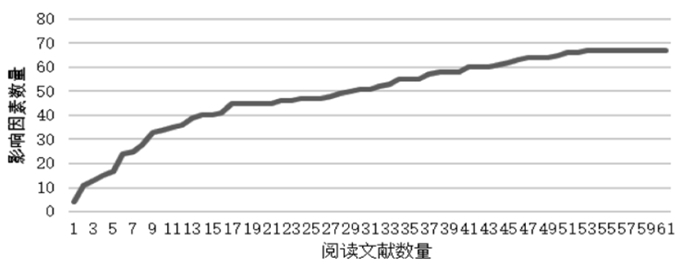Job burnout of medical staff in second and third class public hospitals in China: an analysis based on Chinese literature
-
+ English摘要:目的
了解中国医务人员职业倦怠情况及影响因素的研究现状,总结当前研究的成绩与不足,为未来医务人员职业倦怠的管理和干预提供思路。
方法在知网与万方数据库中根据关键词检索2002—2022年的相关文献,使用Excel软件建立文献评阅库,提取期刊信息、作者信息、职业倦怠的测评量表、影响因素等内容,梳理归纳目前医务人员职业倦怠的影响因素,并绘制饱和曲线;提取采用职业倦怠量表(Maslach Burnout Inventory,MBI)的文献,分析医务人员情绪衰竭、去人格化、成就感降低3个维度的得分情况。
结果检索到205篇相关文献,筛选后纳入76篇文献,均来自《中文核心期刊要目总览》、CSSCI(Chinese Social Sciences Citation Index)或CSCD(Chinese Science Citation Database)期刊。2005之后文献发表数量总体呈现增加的态势。有18篇采用了职业倦怠量表的服务业版本(Maslach Burnout Inventor-Human Service Survy,MBI-HSS),总样本量为8 327,情绪衰竭维度得分为(23.33 ± 10.41)分,去人格化维度得分为(7.98 ± 6.50)分,成就感低落维度得分为(27.29 ± 11.01)分。东部地区医务人员情绪衰竭、去人格化程度最高,但成就感低落程度最低,而西部地区虽情绪衰竭、去人格化程度最低,但成就感低落程度最高(P<0.05)。2010后医务人员情绪衰竭、去人格化程度增高,但成就感低落程度降低(P<0.01)。职业倦怠的影响因素广泛分布在个体因素、组织因素、社会因素三大类。
结论中国医务人员情绪衰竭与去人格化处于中度倦怠水平,成就感低落处于高度倦怠水平。目前对医务人员职业倦怠影响因素的探索日渐丰富,但以横断面研究为主,未来可对不同类别医务人员进行更具体的研究。
-
职业倦怠是在工作中逐渐出现的一系列能量消耗的过程,会影响到一个人的态度、感知和判断[1]。职业倦怠主要表现在情绪衰竭、去人格化与成就感降低三个方面,其中情绪衰竭是指职工的情感资源枯竭,无法调动自己的情绪,感到筋疲力尽;去人格化表现为对周围的人和事漠不关心的状态;成就感降低则表现为对自己在工作中的表现进行消极的评价,无法在工作中获得成就感[2]。
医务人员作为典型的服务性行业的工作人员,需要满足患者的就医需求,工作强度大、工作风险高,是职业倦怠的高发人群[3]。职业倦怠不仅会对医务人员的身心健康状况产生负面影响,影响医务人员的生活与工作状态,甚至可能导致医务人员出现医疗差错,影响医疗质量与医患关系。因此,对于职业倦怠影响因素的探索尤为重要,但我国目前对医务人员职业倦怠影响因素的系统研究较少。本研究拟通过对医务人员职业倦怠的状况及其影响因素进行综述,了解目前我国医务人员职业倦怠研究的现状,梳理目前医务人员职业倦怠的影响因素,分析目前研究中存在的不足,以期更好地设计改善医务人员心理健康的干预措施。
1. 资料与方法
1.1 资料来源
本研究以关键词检索法在知网、万方数据库中检索2002—2022年的《中文核心期刊要目总览》、中文社会科学引文索引(Chinese Social Sciences Citation Index,CSSCI)、中国科学引文数据库(Chinese Science Citation Database,CSCD)期刊。共检索到205篇相关文献。其中,知网数据库的检索关键词为“(医生+ 医务人员+ 医师+ 医护人员+ 护士+ 卫生技术人员+ 护理人员)AND(职业倦怠+ 职业衰竭+ 职业枯竭+ 工作倦怠)AND(影响因素)”,检索到60篇;万方数据库的检索关键词为“(医生or医务人员or医师or医护人员or护士or卫生技术人员or护理人员)AND(职业倦怠or职业衰竭or职业枯竭or工作倦怠)AND(影响因素)”,检索到145篇。
1.2 方法
1.2.1 文献纳入与排除标准
文献纳入标准:(1)研究对象是医务人员;(2)研究内容为职业倦怠的影响因素;(3)研究对象所在单位为二、三级公立医院。基层医疗机构和二、三级医疗机构在卫生服务中的角色定位不同、提供的服务也不一样,而私立医院与公立医院在体制、人员各方面有很大差异,其医务人员职业倦怠的影响因素有其特殊性,因此均未纳入本次研究。
文献中涉及的职业倦怠仅作为预测变量或中介变量、调节变量出现,或只对职业倦怠的因素进行相关性分析的文献不纳入本次研究。
1.2.2 文献分析方法
建立文献评阅库,统计其发表年份、研究对象、使用量表情况并进行计量分析。对于有定量分析数据的文献,提取采用的量表一致且得分明确的文献,计算当前医务人员职业倦怠总体水平;根据国家统计局对我国东、中、西部地区的划分,比较不同地区、不同时期的医务人员职业倦怠的得分情况;通定性整理、统计近20年的医务人员职业倦怠影响因素清单。对于描述性文献或者综述类文献,统计职业倦怠文献的发表年份与研究对象类型。
1.2.3 统计学分析
于SPSPRO在线数据分析平台与SPSS 26.0软件对数据进行统计学分析。符合正态分布的定量资料采用均数±标准差(x ± s)表示,两组间数据差异比较采用摘要独立样本t检验,3组及以上组间数据差异采用摘要方差分析,P < 0.05为差异有统计学意义;使用Excel软件绘制医务人员职业倦怠影响因素清单的饱和曲线,即根据随着阅读数量的增加,影响因素是否呈现不断增加的态势来判断已纳入文献对影响因素的探索是否全面、是否达到饱和。
2. 结果
2.1 文献筛选结果
初步检索到205篇相关文献。进行摘要以及文献阅读后、筛选后,共剔除文献129篇,最后纳入76篇文献,纳入文献均为北大核心、CSCD或CSSCI期刊。见图 1。
2.2 发表年份
76篇文献发表年份分布在2005—2021年,2005—2012年文献发表数量呈现逐年增加的态势,且增长速度较快,其中2012年是发表数量最多的年份,共计11篇;在2013年出现回落,相关论文仅有2篇;在2014年、2017年、2020年出现反弹,发表论文均为6篇。表明自2005年开始,我国对医务人员职业倦怠的研究逐步重视。见图 2。
2.3 研究对象情况
纳入的76篇文献中,研究对象可以分为护理人员(护士)、医生、医护人员(医生与护士)、医务人员(医生、护士、其他医务人员)4类。其中,单独对护理人员进行职业倦怠研究的文献有54篇(占71.05%);单独对医生进行职业倦怠研究的文献有7篇(占9.21%);对医生和护理人员同时进行职业倦怠研究的有8篇(占10.52%);对医务人员进行职业倦怠研究的有7篇(占9.21%)。
进而对研究对象所在科室进行分析,有15篇文献针对特定科室医务人员。其中,对精神病科护士或医生的职业倦怠进行研究的文献有4篇;面向ICU和肿瘤科护士的文献各有2篇;对妇产科、感染性疾病科、急救科、急诊科、神经内科、老年病科、中医科医护人员职业倦怠进行研究的文献各有1篇。
2.4 研究使用的量表
76篇文献中,有61篇是定量研究文献。对职业倦怠进行测量的工具主要使用了Maslach编制的职业倦怠量表(Maslach Burnout Inventory,MBI),该量表包括通用版本(Maslach Burnout Inventor- General Survy,MBI-GS)与服务业版本(Maslach Burnout Inventor-Human Service Survy,MBI-HSS),共计50篇;使用李永鑫编制的中文职业倦怠量表(CMBI)[4]的文献有4篇。有5篇针对护理人员进行职业倦怠研究的文献选用了护士职业倦怠量表(Nursing Burnout Scale,NBS);另有2篇使用了共情疲劳量表。
2.5 医务人员职业倦怠现状
运用Maslach倦怠量表进行问卷调查的文献中,有18篇采用MBI-HSS量表,得到情绪衰竭、去人格化、成就感降低3个维度得分。18篇文献纳入的总样本量为8 327,情绪衰竭维度得分为(23.33 ± 10.41)分,去人格化维度得分为(7.98 ± 6.50)分,成就感低落维度得分为(27.29 ± 11.01)分。文献中使用最多的职业倦怠程度划分标准为:情绪衰竭得分 < 19分为轻度,19 ~ 26分为中度, > 26分为高度;去人格化维度得分 < 6分为轻度,6 ~ 9分为中度, > 9分为高度;个人成就感得分 > 39分为轻度,34 ~ 39分为中度, < 34分为高度[5]。据此标准我国医务人员情绪衰竭与去人格化处于中度倦怠水平,成就感低落处于高度倦怠水平。上述18篇文献中,其中1篇调查了对全国范围内医务人员的职业倦怠(n = 1 228),故将另外17篇文献(n = 7 099)的倦怠情况按照区域划分,得到东部、中部、西部地区医务人员职业倦怠3个维度的得分情况,结果显示:3组人员的情绪衰竭、去人格化、成就感低落维度得分差异均有统计学意义(P < 0.01),其中东部地区医务人员情绪衰竭、去人格化程度最高,但成就感低落程度最低,而西部地区虽情绪衰竭、去人格化程度最低,但成就感低落程度最高。见表 2。以时间范围划分,得到2010年及之前和2010年后的医务人员职业倦怠得分在3各维度的得分差异均有统计学意义(P < 0.01),2010后医务人员情绪衰竭、去人格化程度增高,但成就感低落程度降低。见表 3。
表 2 东、中、西部地区医务人员职业倦怠得分情况及差异性分析(n = 8 327) 项目 东部(n = 3 644) 中部(n = 1 800) 西部(n = 1 655) 全国(n = 1 228) F值① P值 情绪衰竭 25.97 ± 10.63 21.83 ± 8.70 18.36 ± 9.89 24.39 ± 9.98 252.46 <0.01 去人格化 9.35 ± 6.76 8.94 ± 6.70 5.23 ± 5.61 6.24 ± 4.78 230.50 <0.01 成就感低落 30.79 ± 10.03 27.30 ± 11.95 22.58 ± 9.80 23.37 ± 10.12 349.22 <0.01 注: ①东部、中部、西部3组人员比较。 表 3 2010年前后医务人员职业倦怠得分情况及差异性分析(n = 8 327) 项目 2010年及之前
(n = 4 392)2010年之后
(n = 3 935)t值 P值 情绪衰竭 19.83 ± 9.21 27.23 ± 10.30 -34.400 < 0.01 去人格化 7.08 ± 6.33 8.99 ± 6.54 -13.508 < 0.01 成就感低落 26.81 ± 11.64 27.73 ± 10.26 -3.833 < 0.01 2.6 医务人员职业倦怠影响因素分析
2.6.1 影响因素清单
定量研究中确定的职业倦怠的影响因素(P<0.05)可以归为三类:个体因素、组织因素、社会因素。个体因素除了年龄[6-11]、性别[10, 12-13]、学历[14-17]等基本特征之外,还包括个体的人格特征[18-19]、应对方式[18-22]、心理授权[23-24]、心理契约[25]等;组织因素除了科室[26]、工作岗位[27]、职称[27]等工作的基本情况之外,还包括个体对工作、组织的感知情况,如工作压力源[28]、组织支持感[23]、职业获益感[29]、工作满意度[22, 30-31]、职业紧张[31]、职业认同[32]等;社会因素主要集中在社会支持[18, 23, 27, 33]、群众认可与尊重程度[9, 15]两方面。本研究对影响因素进行了整理,见表 4。
表 4 医务人员职业倦怠影响因素清单类别 影响因素 个人因素 个体特征 性别、年龄、学历、婚姻状况、精神共病、伴随疾病数量、平均睡眠时间、生活压力状况、科研兴趣、能否跟上医学知识更新速度、学习新知识或新工作的意愿 个体心理特征 人格特征、依恋类型、应对方式、心理资本、心理授权、自我效能、专业自我概念、自觉健康状况、个体应对资源 组织因素 工作基本情况 医院级别、医院类型、聘用方式、岗位、科室、工作年限、职称、职务、是否带教、月收入、工作安排(固定班、轮班)、每天平均负责患者例数、平均每周工作天数、加班频率、休假情况、夜班频次、夜班工作时间、工作目的、工作要求、工作负荷、工作家庭冲突、心理减压培训、人际沟通培训、培训次数、获得的荣誉与奖励、职场暴力、压力管理、是否参与疫情防疫工作 个体对组织认知状况 职业满意度、心理契约、职业认同、职业认知、工作满意度、职业压力状况、工作压力源、职业紧张状况、职业获益感、组织伦理气氛、组织支持感、护患关系满意度、护士工作应激、角色压力源、专业护理实践环境、组织承诺、职业承诺 社会因素 社会支持、群众认可与尊重程度 2.6.2 影响因素饱和曲线
本研究以边界分析法分析定量研究的文献中有统计学意义(P < 0.05)的影响因素是否饱和,并绘制了影响因素饱和曲线。随着阅读文献数量的增加,影响因素数量也在不断增加,但当阅读到第53篇时,影响因素的数量达到最大值67个,且不再增加,说明对影响因素的探索已经比较全面。见图 3。
3. 讨论
3.1 职业倦怠问题仍须持续关注
本次研究结果显示自2005年以来我国对于医务人员的职业倦怠问题关注有所上升。从研究对象看,对护理人员职业倦怠情况进行研究的文献最多,这可能是因为护士与患者的接触时间更长,工作量大且繁复,加之重医疗、轻护理的现象依然存在[34],所以护理人员的职业倦怠情况引起了更多的关注。从研究的科室看,对精神科医护人员职业倦怠情况进行研究的文献较多,这可能是因为:精神病是一种相对特殊的疾病,需要医务人员时刻保持警惕状态,职业紧张程度高,且经常面对易激惹、有自杀等倾向的精神患者,这对医护人员的心理状态会产生负面影响,同时精神病的治愈率低且复发率高,医护人员成就感低[34-35],因此精神科医护人员的职业倦怠引起更多的关注。
3.2 职业倦怠量表使用情况
医务人员职业倦怠的测量多选用了Maslach职业倦怠量表(MBI),虽然目前测量职业倦怠的量表有很多,如:厌烦倦怠量表(BM)、哥本哈根倦怠量表(CBI)、奥尔登堡倦怠量表(OLBI)等,但可能因为马斯拉奇提出的职业倦怠3因素理论得到了普遍的认可,能更具体地分析判断职业倦怠的情况,且其中的MBI-HSS量表能够较好地适用于医务人员,所以成为使用最广泛的职业倦怠量表。我国学者李永鑫根据我国国情编制了CMBI,但可能因为编制时间较短,目前使用率仍有待提升。
3.3 不同地区、时期医务人员职业倦怠存在差异
东部地区医务人员情绪衰竭、去人格化程度最高,这可能是因为东部地区经济发展水平高,人口密集,医疗需求量大,医务人员工作负荷与压力相对较大,容易导致其情绪衰竭、去人格化;而西部地区医务人员成就感低落程度最高,可能与西部地区发展空间相对较小、医疗基础设施相对落后、工资收入水平相对较低[36]有关。2010年后医务人员情绪衰竭、去人格化提高,成就感低落下降的原因可能在于我国政府进一步在惠民政策、延长门诊时间、扩大医保覆盖、加大医疗救助、探索大病保险机制等方面进行有益探索,进一步释放了医疗需求;公立医院床位数在2012—2016年间增加了87.1万张[37],截至2017年每家公立医院的平均床位数增长至377张[38]。在公立医院规模迅速扩张而医务人员数量并未明显增加的情况下,必然引起医务人员工作负荷加重。东、中部地区需要优化资源配置,充分发挥分级诊疗的优势,减少医务人员的工作负荷;西部地区需要扩展医务人员的发展空间、增加医务人员职业培训的机会,提高个人成就感。
3.4 医务人员职业倦怠影响因素
目前对于医务人员职业倦怠影响因素的探索已经比较全面,影响因素主要集中在个人因素、组织因素、社会因素三类。个人因素如人格特征、依恋类型等倾向于个体的性格特征,不易改变,管理者可以通过分析不同员工的性格特点,将其与工作岗位更好地进行匹配;未婚者以及年龄小的医务人员可能由于缺乏充分的社会支持及工作经验与技能,更容易出现职业倦怠,应适当给予更多的关注;医务人员时常面临突发卫生事件,可通过对医务人员进行应对技能的培训等帮助其选择合适的应对方式,提高其解决问题、调节情绪的能力。
组织因素包括工作满意度、工作压力感等影响因素可以通过组织层面的干预进行改善。如医疗机构可以通过医务人员满意度调查等方式,发挥提高绩效等措施,调动医务人员的工作积极性;通过开展减压培训讲座、建立减压互助小组,来宣传抗压减压的知识和经验,降低职业倦怠程度。
社会因素主要在社会支持与群众认可程度两方面。医疗机构可以通过公众号、短视频等多种途径进行宣传,构建良好的外部环境,树立医务人员的正面形象,形成尊重医护人员的社会氛围,提高医务人员的社会支持感与群众认可度。
本次研究显示,2005年以来我国对医务人员倦怠情况的关注度在不断上升,研究主题广泛多样,对影响因素的探索更加全面,在分析方法上也进行了创新。但依旧存在一定的局限性:(1)量表主要是国外引入,形式单一,未来应积极研发使用适合我国国情的量表。(2)对医生、药师等职业倦怠的研究较少,且对不同工作性质、科室医护人员对比分析的研究较少。(3)目前的研究主要是横断面研究,未来应该将理论与实践进行更好的结合,增加对职业倦怠的干预研究。(4)仅对国内数据库进行了检索,未关注国际上的研究趋势,同时仅纳入了核心期刊进行分析,可能在结果分析上不够全面。
作者声明 本文无实际或潜在的利益冲突 -
表 2 东、中、西部地区医务人员职业倦怠得分情况及差异性分析
(n = 8 327) 项目 东部(n = 3 644) 中部(n = 1 800) 西部(n = 1 655) 全国(n = 1 228) F值① P值 情绪衰竭 25.97 ± 10.63 21.83 ± 8.70 18.36 ± 9.89 24.39 ± 9.98 252.46 <0.01 去人格化 9.35 ± 6.76 8.94 ± 6.70 5.23 ± 5.61 6.24 ± 4.78 230.50 <0.01 成就感低落 30.79 ± 10.03 27.30 ± 11.95 22.58 ± 9.80 23.37 ± 10.12 349.22 <0.01 注: ①东部、中部、西部3组人员比较。 表 3 2010年前后医务人员职业倦怠得分情况及差异性分析
(n = 8 327) 项目 2010年及之前
(n = 4 392)2010年之后
(n = 3 935)t值 P值 情绪衰竭 19.83 ± 9.21 27.23 ± 10.30 -34.400 < 0.01 去人格化 7.08 ± 6.33 8.99 ± 6.54 -13.508 < 0.01 成就感低落 26.81 ± 11.64 27.73 ± 10.26 -3.833 < 0.01 表 4 医务人员职业倦怠影响因素清单
类别 影响因素 个人因素 个体特征 性别、年龄、学历、婚姻状况、精神共病、伴随疾病数量、平均睡眠时间、生活压力状况、科研兴趣、能否跟上医学知识更新速度、学习新知识或新工作的意愿 个体心理特征 人格特征、依恋类型、应对方式、心理资本、心理授权、自我效能、专业自我概念、自觉健康状况、个体应对资源 组织因素 工作基本情况 医院级别、医院类型、聘用方式、岗位、科室、工作年限、职称、职务、是否带教、月收入、工作安排(固定班、轮班)、每天平均负责患者例数、平均每周工作天数、加班频率、休假情况、夜班频次、夜班工作时间、工作目的、工作要求、工作负荷、工作家庭冲突、心理减压培训、人际沟通培训、培训次数、获得的荣誉与奖励、职场暴力、压力管理、是否参与疫情防疫工作 个体对组织认知状况 职业满意度、心理契约、职业认同、职业认知、工作满意度、职业压力状况、工作压力源、职业紧张状况、职业获益感、组织伦理气氛、组织支持感、护患关系满意度、护士工作应激、角色压力源、专业护理实践环境、组织承诺、职业承诺 社会因素 社会支持、群众认可与尊重程度 -
[1] FREUDENBERGER H J. The issues of staff burnout in therapeutic communities[J]. Psychoactive Drugs, 1986, 18(3): 247-251. doi: 10.1080/02791072.1986.10472354
[2] MASLACH C, JACKSON S E. The measurement of experienced burnout[J]. J Organ Behav, 1981, 2(2): 99-113. doi: 10.1002/job.4030020205
[3] 邵岑怡, 张舜行, 台明. 国内外医务人员职业倦怠研究进展[J]. 中华医院管理杂志, 2019, 35(6): 487-489. doi: 10.3760/cma.j.issn.1000-6672.2019.06.010 [4] 李永鑫, 吴明证. 工作倦怠的结构研究[J]. 心理科学, 2005, 28(2): 454-457. doi: 10.3969/j.issn.1671-6981.2005.02.051 [5] 孔燕, 王维利. 护理人员职业耗竭现状调查及影响因素分析[J]. 山东医药, 2012, 52(22): 83-85. doi: 10.3969/j.issn.1002-266X.2012.22.038 [6] 朱伟, 王治明, 王绵珍, 等. 护士工作倦怠及其影响因素评价[J]. 四川大学学报(医学版), 2006, 37(4): 632-635. doi: 10.3969/j.issn.1672-173X.2006.04.034 [7] 周荣慧, 呼滨, 丁炎明, 等. 北京城区综合性医院护士职业倦怠影响因素的追踪研究[J]. 中国护理管理, 2010, 10(9): 27-30. doi: 10.3969/j.issn.1672-1756.2010.09.009 [8] 李丽, 阮洪, 姜虹, 等. 上海市5所三级甲等综合性医院ICU护士职业倦怠影响因素探讨[J]. 中国护理管理, 2013, 13(11): 48-51. https://www.cnki.com.cn/Article/CJFDTOTAL-GLHL201311017.htm [9] 覃蕾, 霍荣瑞, 任闅虹, 等. 基于随机森林算法的肿瘤科护士工作倦怠影响因素分析: 一项多中心研究[J]. 现代预防医学, 2021, 48(21): 4016-4021. https://www.cnki.com.cn/Article/CJFDTOTAL-DDKZ202406010.htm [10] 戴慧芬, 钱桑妮, 魏芳, 等. 医务人员职业倦怠及其影响因素的横断面研究[J]. 中华劳动卫生职业病杂志, 2020, 38(8): 594-597. doi: 10.3760/cma.j.cn121094-20200107-00019 [11] 蔡海燕, 吴文丽. 护士组织承诺对职业倦怠的影响[J]. 中国护理管理, 2014, 14(4): 378-380. https://www.cnki.com.cn/Article/CJFDTOTAL-GLHL201404015.htm [12] 黄粲, 彭宇竹. 医务人员职业倦怠现状及影响因素分析——以江苏省某三甲综合性医院为例[J]. 江苏师范大学学报(哲学社会科学版), 2017, 43(5): 88-98. https://www.cnki.com.cn/Article/CJFDTOTAL-XZSB201705013.htm [13] 陈曲, 刘旭, 孟开. 北京市三级甲等医院青年医护人员职业倦怠现状及其影响因素分析[J]. 中国全科医学, 2018, 21(2): 223-231. https://www.cnki.com.cn/Article/CJFDTOTAL-QKYX201802027.htm [14] 王霞, 金志蓉, 赵宝龙, 等. 护理人员工作场所暴力与工作倦怠调查分析[J]. 护理学杂志, 2015, 30(12): 15-17. https://www.cnki.com.cn/Article/CJFDTOTAL-HLXZ201512006.htm [15] 郭玲, 崔瑛, 郝凯军, 等. 山东省感染性疾病科护士工作压力及工作倦怠的现状及其影响因素研究[J]. 中华护理杂志, 2018, 53(12): 1444-1450. https://www.cnki.com.cn/Article/CJFDTOTAL-ZHHL201812010.htm [16] 宋晶, 黄好华. 临床护理人员组织伦理气氛对职业倦怠的影响[J]. 护理研究, 2020, 34(19): 3487-3489. https://www.cnki.com.cn/Article/CJFDTOTAL-SXHZ202019024.htm [17] 朱靖, 胡丹, 李静娴, 等. 新冠疫情背景下医务人员职业倦怠影响因素分析[J]. 东南大学学报(医学版), 2020, 39(6): 747-752. https://www.cnki.com.cn/Article/CJFDTOTAL-NJTD202006009.htm [18] 薛玲, 顾昕, 庞淑兰, 等. 唐山市某医院护士职业倦怠现状及影响因素分析[J]. 中国工业医学杂志, 2010, 23(6): 447-450. https://www.cnki.com.cn/Article/CJFDTOTAL-SOLE201006022.htm [19] 徐玲琳. 工作环境和人格特征及应对方式对护士工作倦怠的影响[J]. 护理研究, 2012, 26(18): 1652. https://www.cnki.com.cn/Article/CJFDTOTAL-SXHZ201218011.htm [20] 刘慧婷, 郑柏宁, 卢映君, 等. 广州市166名护士工作倦怠及其影响因素分析[J]. 中华劳动卫生职业病杂志, 2019, 37(8): 576-580. [21] 单亚楠, 周钰, 董丽, 等. 秦皇岛市200名低年资护士职业倦怠现状分析[J]. 工业卫生与职业病, 2020, 46(5): 403-405. https://www.cnki.com.cn/Article/CJFDTOTAL-GYWZ202005017.htm [22] 伍小凡, 刘立志. 医院聘用护士职业倦怠与应对方式的关系[J]. 解放军护理杂志, 2012, 29(10): 16-18. https://www.cnki.com.cn/Article/CJFDTOTAL-JFHL201210006.htm [23] 王慧, 刘华平. 北京市三级甲等综合医院护士工作倦怠及其影响因素的研究[J]. 中华护理杂志, 2011, 46(3): 298-299. https://www.cnki.com.cn/Article/CJFDTOTAL-ZHHL201103033.htm [24] 姜兆权, 张会君. 护理人员心理授权、角色压力源与职业倦怠的关系[J]. 中华行为医学与脑科学杂志, 2016, 25(3): 267-270. [25] 周艳辉, 侯爱和, 李文菁. 护士心理契约与工作倦怠的相关性分析[J]. 护理学杂志, 2014, 29(20): 71-74. https://www.cnki.com.cn/Article/CJFDTOTAL-HLXZ201420034.htm [26] 叶兰英, 樊春雷, 王利刚, 等. 某三甲综合医院临床护士职业倦怠现状及影响因素分析[J]. 中华劳动卫生职业病杂志, 2017, 35(10): 754-758. https://www.cnki.com.cn/Article/CJFDTOTAL-HNYG202204044.htm [27] 常青, 李思, 刘秋秋, 等. 313名女护士工作倦怠及其影响因素分析[J]. 中国全科医学, 2010, 13(28): 3208-3210. https://www.cnki.com.cn/Article/CJFDTOTAL-QKYX201028036.htm [28] 娄小平, 朱伟. 河南省某医院护士工作倦怠与工作压力调查[J]. 郑州大学学报(医学版), 2010, 45(5): 823-826. https://www.cnki.com.cn/Article/CJFDTOTAL-HNYK201005039.htm [29] 肖晓玲, 胡秋秋, 刘玉萍, 等. 护士职业获益感及其对职业倦怠影响的研究[J]. 中国护理管理, 2014, 14(1): 56-60. https://www.cnki.com.cn/Article/CJFDTOTAL-GLHL201401022.htm [30] 王海洋, 蒲俊材, 李鹏飞, 等. 我国西部地区神经内科医师职业倦怠现状及其影响因素[J]. 环境与职业医学, 2017, 34(8): 693-697. https://www.cnki.com.cn/Article/CJFDTOTAL-LDYX201708007.htm [31] 王理瑛, 侯燕, 颜萍. 合同护士工作倦怠影响因素的相关性研究[J]. 护理学杂志, 2008(18): 49-51. https://www.cnki.com.cn/Article/CJFDTOTAL-HLXZ200818034.htm [32] 曹晓翼, 陆丽清, 刘晓虹. 专业自我概念在护士职业认同与职业倦怠间的中介效应[J]. 中华护理杂志, 2010, 45(11): 965-968. https://www.cnki.com.cn/Article/CJFDTOTAL-ZHHL201011003.htm [33] 王惠, 张宁. 精神科医生职业倦怠及相关因素分析[J]. 中国临床心理学杂志, 2009, 17(1): 112-114. https://www.cnki.com.cn/Article/CJFDTOTAL-ZLCY200901040.htm [34] 李大勇, 张赫楠, 张雪, 等. 精神科工作场所暴力防范对策探讨[J]. 中国医院管理, 2017, 37(10): 48-49. https://www.cnki.com.cn/Article/CJFDTOTAL-YYGL201710027.htm [35] 姜文海. 精神病专科医院创新发展的路径与思考[J]. 中国医院管理, 2014, 34(10): 60-62. https://www.cnki.com.cn/Article/CJFDTOTAL-YYGL201410032.htm [36] 刘留留. 医务人员职业紧张致职业枯竭的影响因素研究[D]. 南京: 东南大学, 2018. [37] 张涛, 罗昊宇, 张华玲. 我国公立医院规模扩张特点及控制策略研究[J]. 中国卫生产业, 2018, 15(9): 180-182. https://www.cnki.com.cn/Article/CJFDTOTAL-WSCY201809086.htm [38] 方来英. 我国公立医院规模扩张的现状与对策[J]. 中华医院管理杂志, 2019, 35(3): 177-180. https://www.cnki.com.cn/Article/CJFDTOTAL-YYJZ201803029.htm -
期刊类型引用(4)
1. 许皓然,陈启康,倪进东,曾娜,代莎莎,陈国荣,卢敏. 医学人文关怀的临床路径构建与实践——基于整合型的5C+4A服务模式. 广东医科大学学报. 2025(01): 45-50 .  百度学术
百度学术
2. 王静,赵长虹,余泳菁. 女性护士职业倦怠现状及影响因素分析. 心理月刊. 2025(05): 74-76 .  百度学术
百度学术
3. 孙铭薇,叶斯阳,黄淑芸,吴飞,林德明. 东莞市医护人员职业倦怠现状及其影响因素分析. 中国职业医学. 2024(04): 381-384 .  百度学术
百度学术
4. 刘燕,谭凯茜,张建飞. 整形外科护士职业紧张,职业倦怠与睡眠质量的相关性研究. 中国医疗美容. 2024(08): 99-103 .  百度学术
百度学术
其他类型引用(0)






 下载:
下载:


